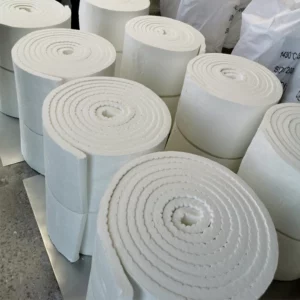Ceramic Fiber Blanket
Showing the single result
Laurel Group, You Have To Know During Ceramic Fiber Industry
Laurel Group is both a top provider and producer of materials for insulation and refractory purposes. Fire clay bricks, high alumina bricks, insulating bricks, and ceramic fiber products are as all included.
Concept Of Ceramic Fiber Blankets By Laurel Group
The manufacturing process of Ceramic Fiber Blanket Insulation involves spinning ceramic fiber. And then needling it in order to have high-temperature insulation applications with outstanding handling strength.
The three standard grades of Ceramic Insulation Blanket are commonly known as:
- Commercial
- High-Purity
- Zirconia grade
The ceramic fiber blanket is made by the ‘blown’ and ‘spun’ process, resulting in long, flexible, interwoven fibers that create a durable blanket suitable for use in temperatures ranging from 1,260 ℃ to 1,600 ℃. Despite being lightweight, the blanket remains strong. The insulation value of refractory ceramic fibre blanket is five times better while retaining the same heat resistance as a hard refractory.
Key Features Of Ceramic Fiber Blanket
- Absorption of sound
- Thermal conductivity is low
- The heat storage is extremely low
- Resistance to thermal shock
- Extremely strong tensile properties
- Free from binder, fumes, or atmospheric contamination
- No need for a curing or drying cycle
Widely Application Examples By Ceramic Fiber Blankets
- Insulation and seals for kiln cars in ceramics
- The Steel industry comprises heat treatment and annealing furnaces, furnace door linings and seals, furnace hot face repairs, and reheating furnace and ladle covers
- Boiler doors, boiler insulation, reusable turbine covers, expansion seals/pipe coverings, refining and petrochemical. They are as related to power generation.
- Refrining and Petrochemical applications include the lining of Reformers and Pyrolysis, insulation of high temperature pipes, ducts, and turbines, and the use of tube seals, gaskets, and expansion joints. Additionally, Crude Oil Heater linings are also as utilized.
Shapes That Are Complicated And Velocities Of Gases
Ceramic Fiber Blanket Wet Wool (WW) as produced particularly for insulation of intricate shapes and applications subjected to elevated hot gas velocities. The wet binder is as retained during shipping and storage by packaging the material in a clear polyethylene bag permeated with inorganic bonding agents. Flexible insulation, resulting from the manufacturing process, can be formed to complex shapes in place and dries in air to form a hard, rigid structure. Meanwhile, the dry density of this material ranges from 12-18 lbs/ft3 (190-290 kg/m3).

